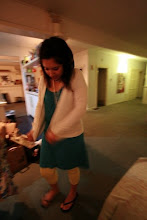
background:
At U.C.Berkeley, being a senior is a lot of work, but also a lot of fun. Especially when you're done with your requirements and are taking classes because you're actually interested in them.. Luckily, I qualify as one of those people, and I was fortunate enough to take a class with Galen Cranz, and amazing professor.
She is teaching a course on "body concious design" and this week, we had to design a shoe which was not anatomically harmful, yet was still culturally acceptable. Take a look at what I did :)
THE SHOE
Anatomically Safe, yet Culturally Acceptable
In this day and age it’s tough to look good, feel comfortable, and be less harmful to the environment ALL at the same time. Luckily, with the new “sustainability” trend, everyone seems to be enthralled with the idea of any new item on the market which is recycled and not as harmful to the environment as it would otherwise be.
This new “shoe” (in quotes because it is more of a boot) is based on the fact that rain-boots, though necessary in the wetter months of the year, are not always the most comfortable. Personally, I have a very high arch, and none of my old rain-boots ever had any arch support, enough padding, and were always too cramped in the toe area for me to be comfortable for any lengthy period of time – lengthy meaning for over 10 minutes.Therefore, the basis of my argument is that even when it is raining we should be able to be as comfortable as we would be in our favorite pair of flip-flops.
To make my point, I have:
1. I used my most comfortable pair of flip-flops. They have adequate padding, arch support, and are black – a very sexy color (I also happened to have bought them for a very small price from the men’s section at my local Target – just goes to show that if you want a shoe you can wear, you might have to venture a little further than you normally would).
2. I attached “bondage” in the form of yellow ribbon, so that they are more securely fastened to my foot.
3. I attached a recycled plastic bag to create the water-proof aspect which rain-boots provide.
4. Attached a ribbon near the back of the heel to give the boot some shape, creating “sex-appeal”
5. Used a ribbon at the top of the plastic to allow the boot to be adjustable. An elastic band would cut off circulation, and no one has the same size calf so the ribbon was to take away the generic, one-size-fits-all approach to life.
And thus, voila, I formed my shoe. Comfortable because of the generous support provided by “MOSS shoes”, and in-style thanks to the multiple recycled items used to create this beautiful piece of technology.
Rain, rain, no need to go away, I have my WPF-boots, and they’re here to stay!

No comments:
Post a Comment